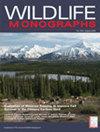Pathogens, Nutritional Deficiency, and Climate Influences on a Declining Moose Population
IF 3.8
1区 生物学
Q1 ECOLOGY
引用次数: 221
Abstract
Abstract Several potential proximate causes may be implicated in a recent (post-1984) decline in moose (Alces alces andersoni) numbers at their southern range periphery in northwest Minnesota, USA. These causes include deleterious effects of infectious pathogens, some of which are associated with white-tailed deer (Odocoileus virginianus), negative effects of climate change, increased food competition with deer or moose, legal or illegal hunting, and increased predation by gray wolves (Canis lupus) and black bears (Ursus americanus). Long-standing factors that may have contributed to the moose decline include those typically associated with marginal habitat such as nutritional deficiencies. We examined survival and productivity among radiocollared (n = 152) adult female and juvenile moose in northwest Minnesota during 1995–2000, and assessed cause of death and pathology through carcass necropsy of radiocollared and non-radiocollared animals. Aerial moose surveys suggested that hunting was an unlikely source of the numerical decline because the level of harvest was relatively low (i.e., approx. 15% / 2 yr) and the population usually grew in years following a hunt. The majority of moose mortalities (up to 87% of radiocollared moose [n = 76] and up to 65% of non-radiocollared moose [n = 84]) were proximally related to pathology associated with parasites and infectious disease. Liver fluke (Fascioloides magna) infections apparently constituted the greatest single source of mortality and caused significant pathology in the liver, thoracic and peritoneal cavities, pericardial sac, and lungs. Mortality due to meningeal worm (Parelaphostrongylus tenuis) was less prevalent and was manifested through characteristic neurological disease. Several mortalities apparently were associated with unidentified infectious disease, probably acting in close association with malnutrition. Bone-marrow fat was lower for moose dying of natural causes than those dying of anthropogenic factors or accidents, implying that acute malnutrition contributed to moose mortality. Blood profiles from live-captured animals indicated that those dying in the subsequent 18 months were chronically malnourished. Relative to other populations, average annual survival rates for adult females (0.79 [0.74–0.84; 95% CI]) and yearlings (0.64 [0.48–0.86]) were low, whereas those for calves (0.66 [0.53–081]) were high. Pregnancy (48%) and twinning (19%) rates were among the lowest reported for moose, with reproductive senescence among females being apparent as early as 8 years. Pregnancy status was related to indices of acute (i.e., bone-marrow fat) and chronic (i.e., blood condition indices) malnutrition. Opportunistic carcass recovery indicated that there likely were few prime-aged males (>5 yr old) in the population. Analysis of protein content in moose browse and fecal samples indicated that food quality was probably adequate to support moose over winter, but the higher fecal protein among animals that died in the subsequent 18 months could be indicative of protein catabolism associated with malnutrition. Trace element analysis from moose livers revealed apparent deficiencies in copper and selenium, but there was limited evidence of direct association between trace element concentrations and moose disease, pathology, or mortality. Time-series analysis of regional moose counts (1961–2000) indicated that annual population growth rate was related negatively to mean summer temperature, with winter and summer temperatures increasing by an average of 6.8 and 2.1 C, respectively, during the 40-year period. This change may have increased moose thermoregulatory costs and disrupted their energy balance, and thereby reduced their fitness. Time-series analysis failed to show a relationship between annual population growth rate and moose or deer abundance, indicating that food limitation via resource competition was unlikely. Population viability analyses, using count data (1961–2000) and demographic data collected during this study, suggested that the northwest Minnesota moose population likely would not persist over the next 50 years. More broadly, we conclude that the southern distribution of moose may become restricted in areas where climate and habitat conditions are marginal, especially where deer are abundant and act as reservoir hosts for parasites.病原体、营养缺乏和气候对驼鹿数量下降的影响
美国明尼苏达州西北部驼鹿(Alces Alces andersoni)南部边缘地区最近(1984年后)数量下降可能涉及几个潜在的近因。这些原因包括传染性病原体的有害影响,其中一些与白尾鹿(Odocoileus virginianus)有关,气候变化的负面影响,与鹿或驼鹿的食物竞争加剧,合法或非法狩猎,以及灰狼(Canis lupus)和黑熊(Ursus americanus)的捕食增加。可能导致驼鹿数量下降的长期因素包括那些通常与边缘栖息地有关的因素,如营养缺乏。1995-2000年间,研究人员在明尼苏达州西北部对152只带放射项圈的成年母驼鹿和幼驼鹿的存活率和生产力进行了研究,并通过对带放射项圈和未带放射项圈动物的尸体尸检评估了它们的死亡原因和病理情况。对驼鹿的空中调查表明,狩猎不太可能是数量下降的原因,因为收获的水平相对较低(即大约为2000年)。15%/2年),种群数量通常在狩猎后的几年内增长。大多数驼鹿的死亡(高达87%的带放射项圈的驼鹿[n = 76]和高达65%的未带放射项圈的驼鹿[n = 84])与与寄生虫和传染病相关的病理近端相关。肝吸虫(大片形吸虫)感染显然是最大的单一死亡来源,并引起肝脏、胸腔和腹膜腔、心包囊和肺部的显著病理变化。由脑膜虫(细斜圆线虫)引起的死亡率较低,表现为特征性神经系统疾病。有几例死亡显然与不明传染病有关,可能与营养不良密切相关。死于自然原因的驼鹿骨髓脂肪含量低于死于人为因素或事故的驼鹿,这意味着急性营养不良导致了驼鹿的死亡。活体捕获动物的血液分析表明,在随后的18个月里死亡的动物是慢性营养不良。相对于其他种群,成年雌性的年平均存活率为0.79 [0.74-0.84;95% CI[0.64[0.48-0.86])较低,而犊牛(0.66[0.53-081])较高。据报道,驼鹿的怀孕率(48%)和双胞胎率(19%)是最低的,雌性早在8岁时就明显出现生殖衰老。妊娠状态与急性(骨髓脂肪)和慢性(血液)营养不良指标有关。机会性的尸体恢复表明可能很少有壮年雄性(。5岁)。对驼鹿食物和粪便样本中蛋白质含量的分析表明,食物质量可能足以支持驼鹿过冬,但在随后的18个月里死亡的动物中较高的粪便蛋白质可能表明蛋白质分解代谢与营养不良有关。对驼鹿肝脏的微量元素分析显示,铜和硒明显缺乏,但微量元素浓度与驼鹿疾病、病理或死亡率之间的直接联系证据有限。1961—2000年区域驼鹿数量的时间序列分析表明,驼鹿年增长率与夏季平均气温呈负相关,冬季和夏季平均气温在40 a期间分别上升6.8℃和2.1℃。这种变化可能增加了驼鹿的体温调节成本,破坏了它们的能量平衡,从而降低了它们的适应性。时间序列分析未能显示驼鹿或鹿的年人口增长率与丰度之间的关系,这表明不太可能通过资源竞争来限制食物。利用1961-2000年的统计数据和本研究中收集的人口统计数据进行的种群生存能力分析表明,明尼苏达州西北部的驼鹿种群在未来50年内可能不会持续存在。更广泛地说,我们得出结论,驼鹿的南部分布可能会在气候和栖息地条件较差的地区受到限制,特别是在鹿数量丰富并充当寄生虫宿主的地区。 摘要 一个recientedisminución(1984年)在númerode驼鹿分布在南部边界noroestede明尼苏达州他可能由于各种原因包括传染病原体的影响。其中一些是与白尾鹿(Odocoileus virginianus)、气候变化的负面影响,增加与鹿或驼鹿争夺食物,合法和非法狩猎,以及狼(Canis lupus)和黑熊(Ursus americanus)捕食的增加。其他可能导致麋鹿数量下降的长期因素包括那些通常与边缘栖息地有关的因素,如营养不足。我们评估了1995 - 2000年明尼苏达州西北部带无线电项圈的成年雌性和幼麋鹿(n = 152)的存活率和生产力,并在适当时通过对带无线电项圈和不带无线电项圈的动物进行尸检确定死亡原因和病理。空中旅行表明,狩猎并不是减少的主要原因,因为收获的动物数量相对较低(2年约15%),而且总体而言,在狩猎后的几年里,种群数量增加了。大多数麋鹿死亡(高达87%的带无线电项圈的麋鹿死亡[n = 76];65%的无领驼鹿(n = 84)是由于与寄生虫和传染病相关的病理。肝吸虫感染(大片形片虫)显然是最重要的死亡原因,并在肝脏、胸腔和腹膜、心包囊和肺中引起重大病变。脑膜虫(Parelaphostrongylus tenius)的死亡率较低,作为一种特征性神经疾病表现较差。一些死亡显然与不明传染病有关,可能与营养不良相互作用。自然死亡的驼鹿的骨髓脂肪比人为因素或事故死亡的驼鹿少,这表明急性营养不良是导致死亡的原因。对捕获的活的动物进行的血液分析表明,在随后18个月内死亡的动物长期营养不良。成年雌性和成年雌性的年平均存活率较低(0.79 [0.74 - 0.84;95% ci]和0.64[0.48 - 0.86]),而幼鹿存活率较高(0.66[0.53 - 0.81]),与其他麋鹿种群相比。在本研究中,我们分析了两种不同类型的驼鹿,一种是雄性驼鹿,另一种是雌性驼鹿。怀孕状况与急性营养不良指数(骨髓脂肪)和慢性营养不良指数(身体状况血液指数)有关。对机会主义发现的尸体的评估表明,成熟的雄性肯定很少(> gt;5岁)在人口中。植物中的蛋白质含量分析葬身于驼鹿和粪便样本中指出,质量是适当的饮食来保持驼鹿在冬季,但含有大量发现动物的粪便样本中捕获蛋白死于下列18个月可能是象征一个分解代谢种蛋白质营养不良有关。对麋鹿肝脏中微量元素的分析显示,铜和硒明显缺乏,但微量元素浓度与麋鹿疾病、病理或死亡率之间几乎没有关联。票的时间序列分析驼鹿(1961年—2000年)指出,年度增长率负面与夏天,平均温度增加,平均温度在冬季和夏季分别约6.8和2.1 C 40岁期间。这些变化可能增加了麋鹿的温度调节成本,影响了它们的能量平衡。时间序列分析未能显示麋鹿种群的估计增长率与麋鹿和/或鹿的丰度之间的关系,这表明麋鹿种群不受食物竞争的限制。利用统计数据(1961 - 2000年)以及本研究收集的人口统计数据进行的种群生存能力分析表明,明尼苏达州西北部的麋鹿种群不会持续超过50年。 在本研究中,我们分析了麋鹿种群的分布情况,并对麋鹿种群的分布情况进行了分析,得出的结论是,麋鹿种群的分布将受到限制,因为它们的栖息地条件是边缘的,而麋鹿种群是丰富的,并作为寄主。病原体、营养缺乏和气候对驼鹿数量下降的影响摘要几个因素可能与最近(自1984年以来)明尼苏达州西北部驼鹿(Alces Alces andersoni)分布范围以南的驼鹿数量下降有关。这些因素可能包括病原体感染的有害影响,其中一些与弗吉尼亚鹿(Odocoileus virginianus)有关,气候变化的负面影响,与鹿或驼鹿的食物竞争加剧;狩猎——合法或非法,狼(Canis lupus)和黑熊(Ursus americanus)的捕食增加。一些长期存在的因素可能导致驼鹿数量的下降,包括那些与不稳定的栖息地和营养不足有关的因素。1995 - 2000年,在明尼苏达州西北部使用发射项圈评估了雌驼鹿和幼驼鹿(n = 152)的存活率和生产力。通过对装有发射器项圈的动物尸体和偶然发现的其他尸体进行尸检,还评估了死亡原因和病原体的存在。对驼鹿的空中盘点并没有支持狩猎是数量下降的原因的假设,因为收获水平相对较低(即。大约每两年15%),并且在一年的狩猎后数量增加。观察到的大多数死亡(高达87%的驼鹿带项圈[n = 76];高达65%的无项圈驼鹿(n = 84)与寄生虫和传染病有关。美国大吸虫(片形虫)引起的感染似乎占死亡的最大比例,也是肝脏、胸腔和腹腔、心包和肺疾病的主要原因。由脑膜虫(细小副圆线虫)引起的死亡较少,表现为神经系统疾病。一些死亡与不明传染病有关,可能与营养不良有关。与死于事故或人为原因的驼鹿相比,死于自然原因的驼鹿的骨髓脂肪较少,这证实了急性营养不良导致驼鹿死亡的假设。活体捕获动物的血液特征表明,在捕获后18个月内死亡的动物处于慢性营养不良水平。成年雌性的年平均存活率(0.79 [0.74 - 0.84;95% ci])和幼崽(0.64[0.48 - 0.86])较低,而犊牛(0.66[0.53 - 0.81])的存活率较高。妊娠率(48%)和gémellité(19%),最低点之一家,驼鹿和报道也出现了雌性的生殖衰老。早在8岁时已与predisposition至妊娠急性营养不良的索引()和慢性骨髓脂肪指数(血液中)。偶然发现的成年雄性(> 5岁)尸体很少,这表明它们在种群中非常少。内容分析蛋白质的brouts d’orignaux和粪便样本显示可用的食物质量很可能足以忍受寒冬,但较高的蛋白质,动物粪便里发现死在接下来的18个月,可以参考相关蛋白的分解代谢不良。肝脏微量元素分析显示铜和硒缺乏,但微量元素浓度与驼鹿健康/死亡率之间的直接关系很低。时序分析上的对账单d’orignaux(1961年—2000年)已经表明,区域人口增长率是负相关,与夏季和冬季的温度,夏季平均气温分别增长6.8和2.1 C期为40岁。这种变化可能导致成本的增加,温度调节和能量平衡中的驼鹿决裂。 然而,时间分析并没有显示驼鹿种群的估计增长率与白尾鹿或驼鹿的数量之间的关系,这表明不太可能通过竞争来限制食物。利用库存数据(1961 - 2000年)和研究期间收集的人口统计数据,对明尼苏达州西北部驼鹿种群的生存能力进行了分析,表明该种群预计将在未来50年内灭绝。综上所述,驼鹿分布区域的南部很可能是有限的栖息地,那里有大量的白尾鹿和寄生虫来源。
本文章由计算机程序翻译,如有差异,请以英文原文为准。
求助全文
约1分钟内获得全文
求助全文
来源期刊

Wildlife Monographs
生物-动物学
CiteScore
9.10
自引率
0.00%
发文量
3
审稿时长
>12 weeks
期刊介绍:
Wildlife Monographs supplements The Journal of Wildlife Management with focused investigations in the area of the management and conservation of wildlife.
Abstracting and Indexing Information
Academic Search Alumni Edition (EBSCO Publishing)
Agricultural & Environmental Science Database (ProQuest)
Biological Science Database (ProQuest)
CAB Abstracts® (CABI)
Earth, Atmospheric & Aquatic Science Database (ProQuest)
Global Health (CABI)
Grasslands & Forage Abstracts (CABI)
Helminthological Abstracts (CABI)
Natural Science Collection (ProQuest)
Poultry Abstracts (CABI)
ProQuest Central (ProQuest)
ProQuest Central K-543
Research Library (ProQuest)
Research Library Prep (ProQuest)
SciTech Premium Collection (ProQuest)
Soils & Fertilizers Abstracts (CABI)
Veterinary Bulletin (CABI)
 求助内容:
求助内容: 应助结果提醒方式:
应助结果提醒方式:


